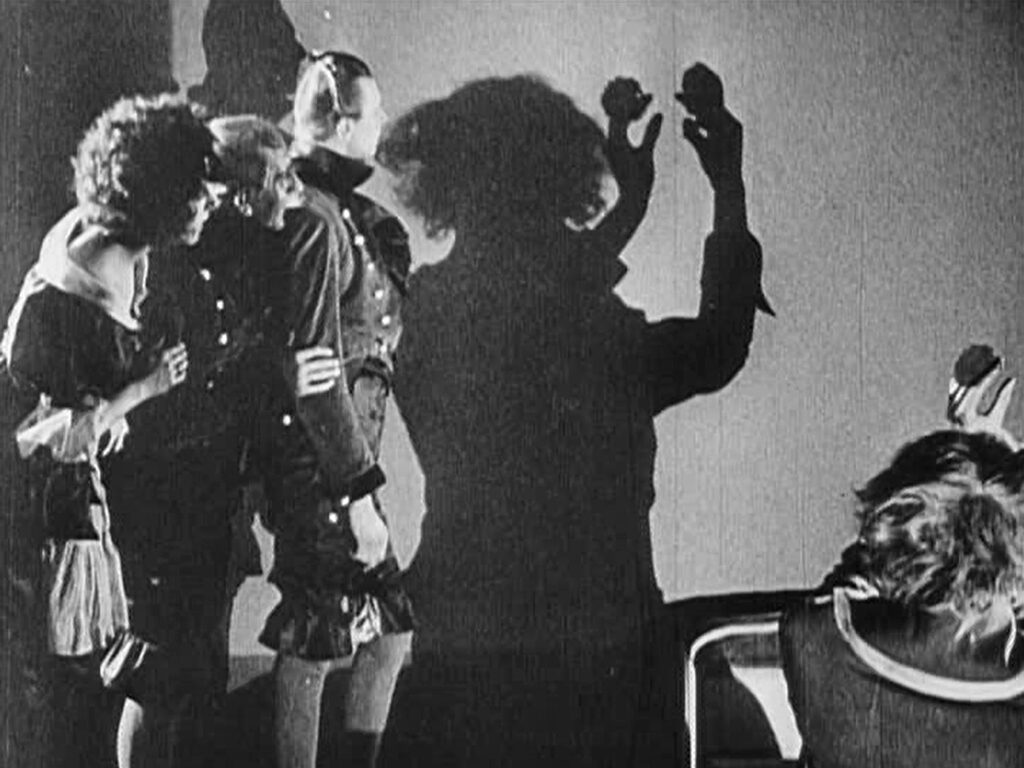
Warning Shadows
1923, directed by Arthur Robison
To devotees of Asian puppet theater, the shadow is considered the soul of the puppet. When the traveling entertainer in Warning Shadows stages his Chinese shadow play, he dramatically pulls his spectators’ shadows in toward the screen as if he’s stealing their souls as material for his drama. But like Dr. Caligari, this sinister-looking mountebank proves benevolent in the end. He’s only borrowing their souls for their edification, returning them later with needed improvements.
These two turning points – the first one 36 minutes in, when the showman magically draws his audience by their shadows to the other side of the table; and the second after an equal duration, 36 minutes later, when he reveals them frozen at their worst on a cinema screen – are the keys to Warning Shadows. The shadow play has literally been transformed into a movie. The aristocratic household, including servants and guests, having been fully absorbed into the play, have become protagonists in a cinematic melodrama revealing the logical outcomes of their passions, flirtations, and jealousies. Once the truth is revealed and understood, the cinema screen reverts to the original Chinese puppet theater for a quick and just resolution.
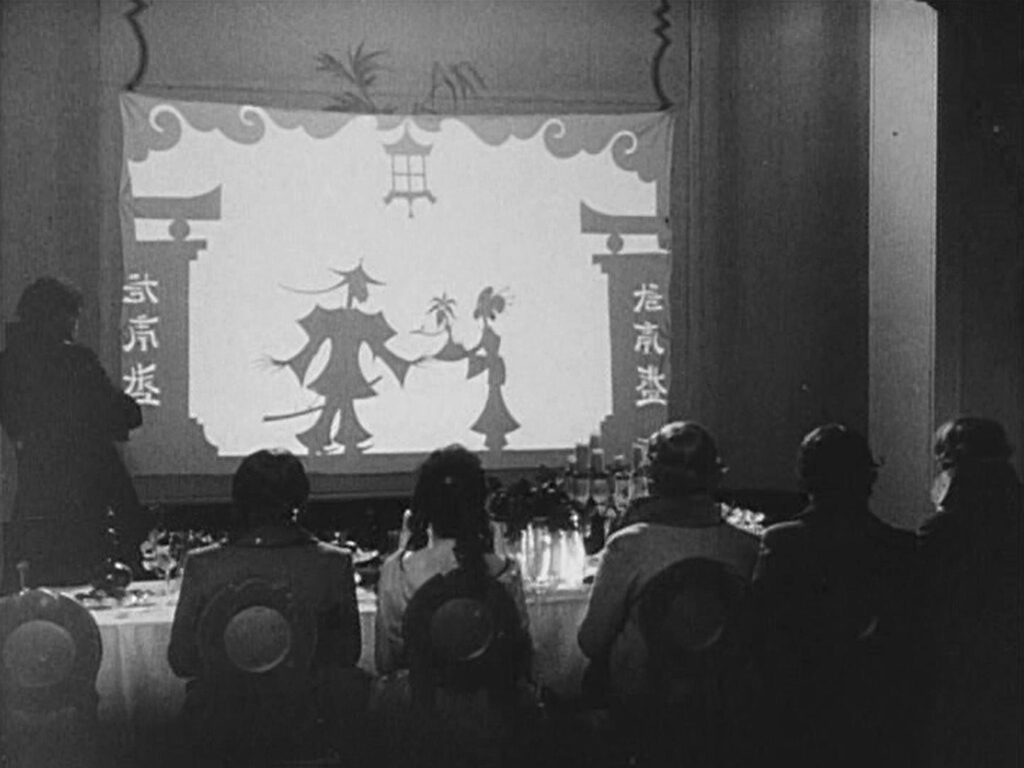
We have, therefore, a classic framing story in the mold of Caligari or The Wizard of Oz, where the fantastic inner story, the movie-within-a-movie in this case, comments on the “real” outer story. But neither the melodrama of Warning Shadows, nor its moral lesson of marital fidelity, are terribly remarkable in themselves. What distinguishes the movie is the power of its metaphor – not merely that cinema consists of projected shadows, but that movies should be capable of reforming people.
This constructive notion of cinema, with its belief in movies’ social utility, is somewhat lost to us today. How many viewers or critics still think the main purpose of movies is to make us better people? But serious reflection on the history of silent and early sound film shows that such optimistic beliefs were once more widely held.
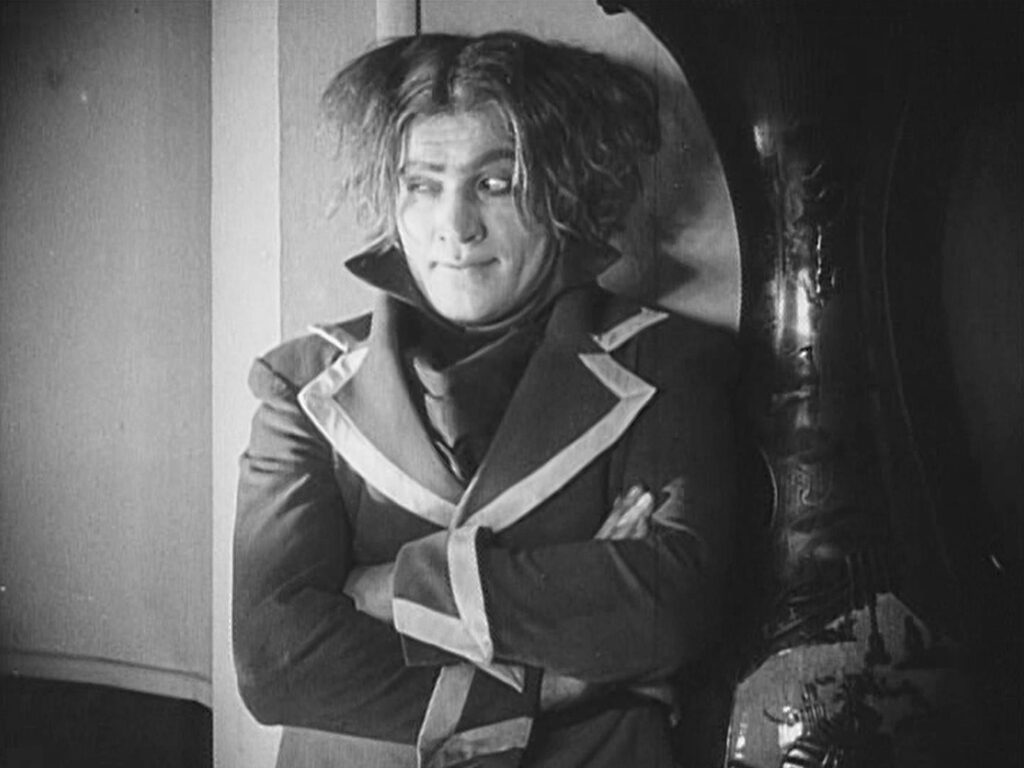
Warning Shadows opens with the image of a screen, framed by curtains as movie screens traditionally were and often still are. In front of the screen a hand picks up and wields a lit candle, the flame representing the power to cast shadows. Before the characters are successively introduced, the giant shadow of a pair of hands spreads over the screen, displaying their range of motion. Later a similar gesture will identify this pair of hands with the traveling entertainer, the maker of cinema. The hands and the candle are important symbols: the movie will be about the work of cinema – not the making of movies, but the work that movies do upon their audience.
Following the entertainer’s hands, the first character introduced is the baron, the star of the melodrama. He strikes a few proud poses then begins looking around, shading his eyes with his hand to emphasize the act of looking. It’s the gesture of a jealous husband, but there’s a double meaning. Already we are told the complete arc of his character – after numerous deceptions and errors motivated by pride, he will finally learn to see.
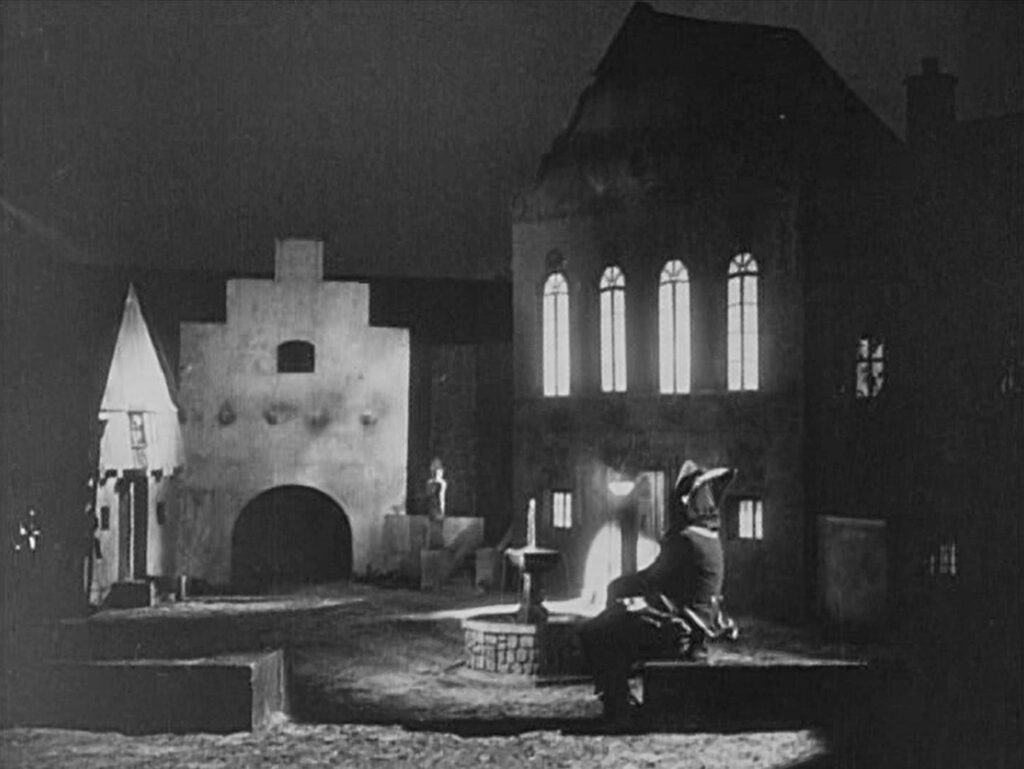
After the introductions, the story begins in earnest with the traveling entertainer descending into the market square in front of the baron’s manor. His character may play a supporting role in terms of screen time, but ultimately it’s his movie – he will be both our guide and the plot’s driving force. The setting could hardly be more universal: the market square, although recognizably German, is shorthand for the public sphere, society at large; and the baron’s house, although elevated in social status like so many movie settings, is the private realm, the personal or family unit. The entertainer will work his magic inside the house, but his work is situated in a broader social context. Movies are no different. In their early decades at least, the task of movies was to model, inspire, correct, and reinforce individual behavior, with the purpose of improving society. Certainly they were expected to entertain, but back then a nobler additional purpose was de rigueur. An uncountable number of films from the silent era and the Great Depression were about maintaining a healthy marriage or fulfilling familial duties. In Warning Shadows the entertainer’s greatest achievement is to restore a happy and trusting marriage within the baron’s house. Shaming and driving away the husband’s rivals is merely a prerequisite to the main task.
Until the crucial scene at the table during the Chinese shadow play, the entertainer works to earn the household’s trust, which he achieves, oddly enough, by mocking them with funny shadows. He turns the head servant’s shadow into a donkey and then a dog, and he caricatures the master’s face. Early cinema had followed a similar development – before winning the respect needed to tackle important social and psychological issues, the first movies, like the entertainer’s caricatures, were brief and simple carnival attractions.
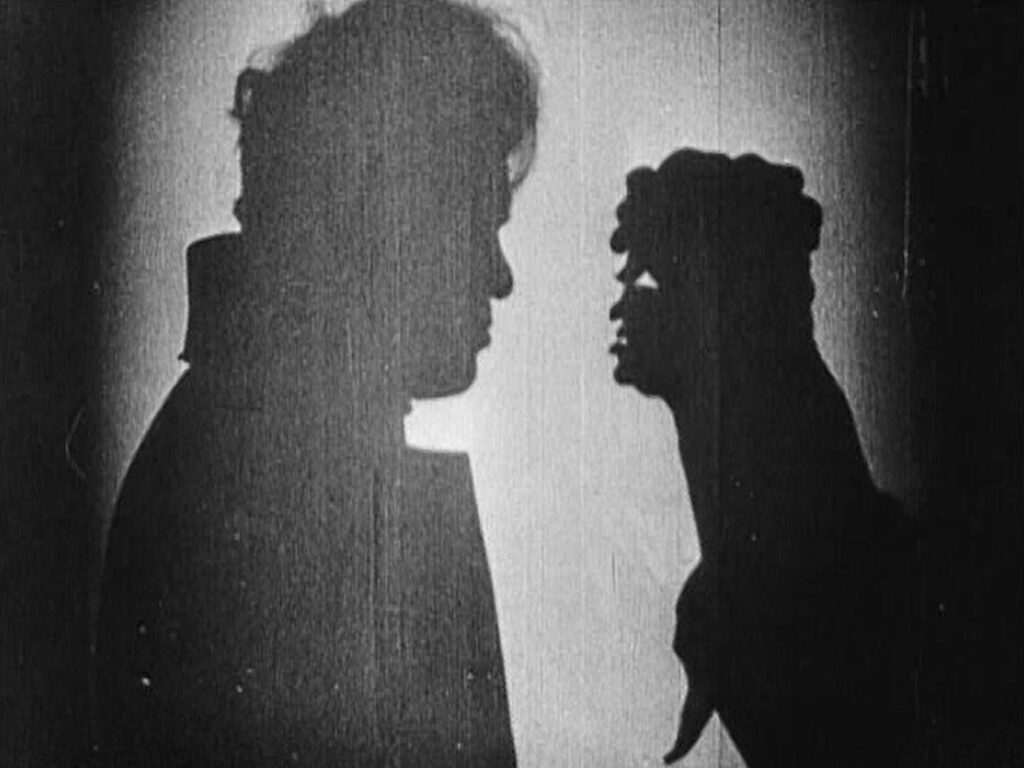
Once the guests are seated for the main performance, the entertainer starts his Chinese puppet show. In a parallel way, the earliest narrative films drew from traditional modes of storytelling: novels, plays, short stories, an occasional opera, even puppet theater in the case of Lotte Reiniger. But just as the opening of Caligari prophesies special psychological powers in cinema (the old man’s ghost story representing 19th century literature and Francis’ strange and wondrous confession representing cinema), so too does Warning Shadows place a special faith in movies as a uniquely persuasive medium of personal and social influence.
Like Dr. Caligari and Dr. Mabuse, two other scraggly-haired characters from Weimar cinema, the traveling entertainer is a hypnotic figure, and his magical storytelling, i.e. cinema, is the expression of his hypnotic powers. When he pulls the viewers’ shadows toward the screen it’s a metaphor for absorption; after a couple minutes of obligatory exposition in his shadow play, there comes a point, like in a movie, where the audience is drawn into the experience as if by magic. The process is reversed shortly before the play’s end when the entertainer draws the viewers’ shadows back to their original positions and the shadow puppets take over again.
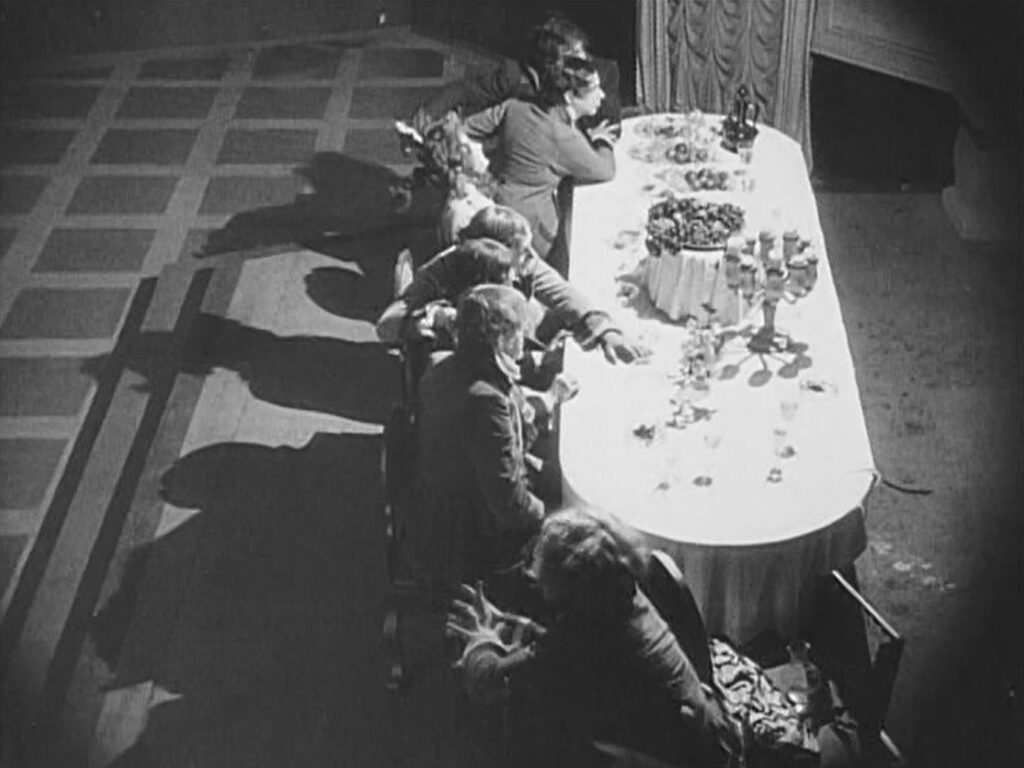
But there’s a key difference between these two supernatural transitions that bracket the inner movie. At the first transition, when the shadows are pulled in, the people at the table turn their heads and witness what’s happening to their shadows. When their shadows are restored 36 minutes later they’re in a stupor and do not notice what’s happening. The usual assumption, when people ask how movies work, is that there’s something mysterious about the way movies draw people in, as if it happens without their awareness – but in these two scenes Warning Shadows suggests that movie viewers are generally aware of their “hypnosis”; they’re willing participants; and the real mystery is how movies reconnect viewers to their own reality at the end, because this step occurs without their awareness.
The six audience members in Warning Shadows may be mystified by their return to reality, but looking from outside we can clearly see what connects the entertainer’s fiction to their real lives. The plot of this movie-within-the-movie has been a seamless continuation of all the events, relationships, and motivations exposed during the party so far. The baroness consummates her dalliance with the young man, the suspicious baron follows and catches them, he orders the servants to tie up his wife on the table, he compels the cowardly guests to kill his wife with swords, he goes mad, and the emboldened guests drive him out the window to his death. Everything follows like a nightmare from the real world, which is why the audience so easily forgets that it’s watching a movie.
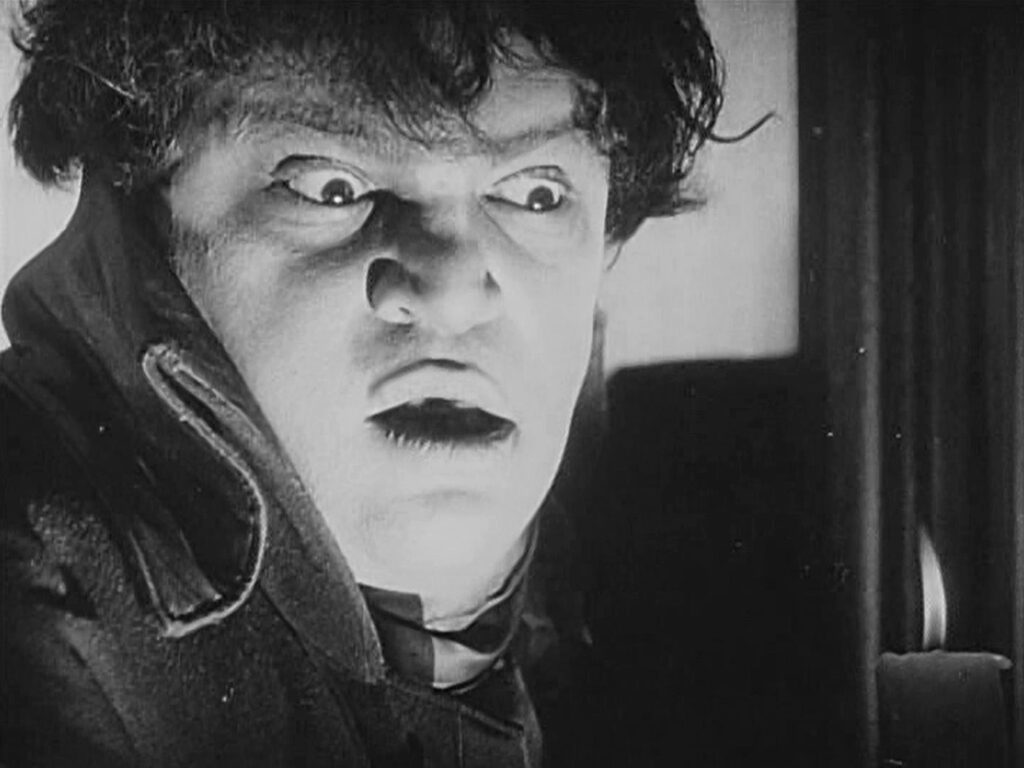
The movie within the puppet show is magically tailored to its participants’ lives, but real movies are not so different. A great part of their skill is to address their particular audience so knowingly that viewers will recognize their own situations on the screen and draw lessons from it. Some movies address a universal audience, and some speak to the specific time and place where they’re made, but in the latter case if the movie is good there’s usually something universal to be gained from it.
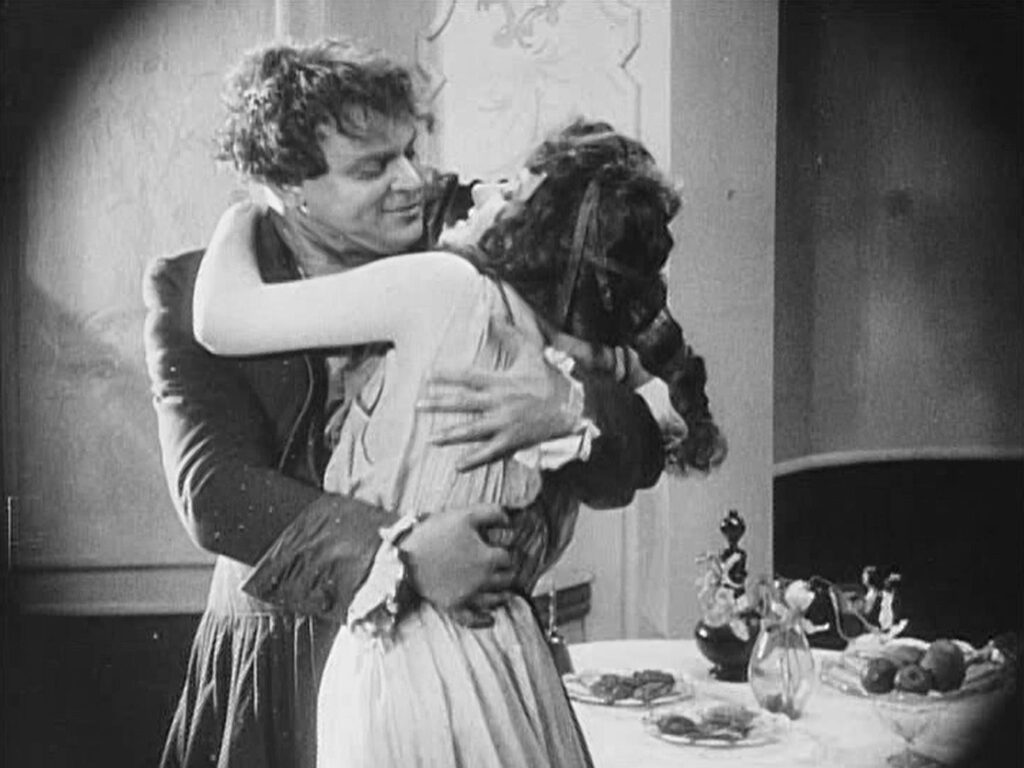
At the end of Warning Shadows, when harmony is restored, the guests are gone, and the baron and his wife have rediscovered their love, the traveling entertainer, having been been thanked and paid, returns to the market square where he leaps onto the back of an escaped pig and rides off through an archway. It’s significant that he leaves through the opposite side of the square from his entrance. He’s making progress, moving on to his next good deed, as cinema itself will presumably continue its positive work. But the pig is an honest reminder of the cinema’s lowly origins. The traveling showman is a trickster, and his medium, i.e. shadows – as the movie constantly reminds us – can just as easily be used to deceive as to enlighten.
CONNECTIONS:
The Cabinet of Dr. Caligari – Framing story; traveling entertainer with wild hair who appears sinister but proves benevolent; love triangle with jealousy and murder; expressionist design elements; allegory of cinema
Sherlock Jr. – Film within the film that reflects and continues the preceding story
The Student of Prague – Shadow as a character’s soul
The Hypothesis of the Stolen Painting – Definition of the power of cinema; warning about its double edge; metaphor for audience absorption
Inland Empire – Movie within a movie; wealthy man jealous of his wife; power of cinema for good and bad; lights in opening titles representing cinematic apparatus; characters see themselves from outside